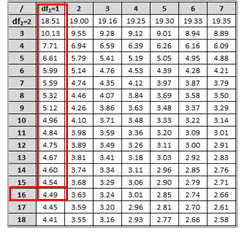
Because the F-distribution is not symmetrical and there are no negative values, you cannot just take the right critical value and use the opposite of it as the left critical value. (Remember we have defined F such that the larger value of the variances is always the numerator this forces the test into the right tail). When we test hypotheses using the F-test, there are our usual suspects for our alternative hypothesis: >, s 2 2.

Here we are interested in using ‘technology’ to conduct our F-test, specifically Excel. With these three factors, we can use F-tables and I’ll leave that process to others to explain, e.g. To find our critical value of F, F crit, we need another determinant, the value of probability, our alpha. Important: F(3,8) is not equal to F(8,3). A specific F-distribution is denoted as F(ndf, ddf) where ndf is the numerator degrees of freedom and ddf is the denominator degrees of freedom, e.g. It is worth remembering that the F-distribution is really a family of distribution curves that vary according to the degrees of freedom of the numerator and denominator in our equation for F. For our purposes, we are most interested in the area above x = 1, but the smaller values are important and we will look at that a bit later in this discussion.įigure 1: F-distribution F-test Critical Area As you can see, the F-distribution ranges from 0 to infinity with a peak value a little less than x = 1. Fisher – the Fisher F probability distribution. The F-distribution is named after, as you might guess, a famous statistician R.A. I need to regress a bit and talk about the F-distribution (figure 1). This means the F-statistic has values greater than 1. The larger sample variance is always s 1, the numerator the smaller sample variance is always s 2, the denominator. But we have specific requirements for calculating the F-statistic. If the null hypothesis is true, the ratio will be equal to 1 the variances are equal. The F-test statistic we use is simply the ratio of the two population variances: F = s 1 2/s 2 2. This important assumption is that the null hypothesis is true. In the F-test, we make one important assumption that results in a ‘simplified’ calculation process. When we want to compare the variance of two populations, we use the F-test. Soo with that long-winded introduction…Dawn on solving F-test problems with Excel. I’ll of course have to augment this with the actual words I record but Camtasia has a tool for that (thank goodness). Which brings me to this, my draft script for solving F-test problems using Excel’s built-in functions. But it is now necessary to include closed captioning for materials used in most online courses and I need to do that. I am going to use Camtasia to capture my screen while I solve several problems using Excel. But I could not find one that would help them for their homework and exams in our auxiliary course management system where most problems give them intermediate data such as means and standard deviations for samples. This is great and I pointed my students to some of them. Unfortunately, all I found were focused on cases where raw data is available. So it was not unusual for me to look for good tutorials on You Tube for the F-test using Excel. So I have moved my recommendation to my students away from more dedicated (and expensive) programs such as SPSS and toward Excel. Microsoft Office as their basic IT tools. Moreover, many, if not most, companies use

Fortunately, most MBA students become at least familiar with Excel during their MBA if they were not already familiar with it.
#Critical value calculator f test free
statistical software, available, some free and some expensive for an individual to buy.
#Critical value calculator f test how to
students, I am more concerned with my students leaving the course knowing how to use technology to help them solve business problems than with their having an in-depth knowledge of statistical theory or memorizing equations. Because these students are MBA students and not Ph.D.

I have found a lot of good statistics tutorials on You Tube and have recommended some to my students.

I teach graduate statistics, otherwise known as quantitative methods/analytics.


 0 kommentar(er)
0 kommentar(er)
